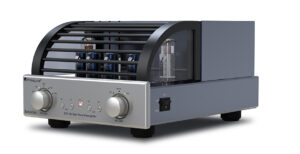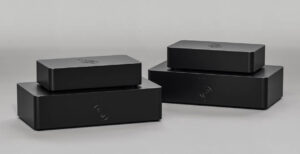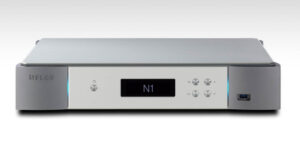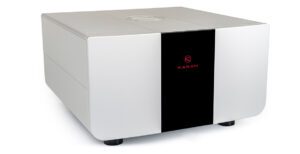
I’ve struggled with working out precisely how to classify the KEF LS50 Wireless. It’s a loudspeaker. It’s an active loudspeaker. It’s a complete system. It’s audio’s tomorrow, today. It’s damn clever, and extendable and flexible enough to keep up with damn clever for the next few years at least. That doesn’t exactly make for a pithy headline, however, so we went with ‘system’.
We went with ‘system’ because that’s precisely how KEF envisaged the LS50 Wireless. It’s the 2017 interpretation of a system, or at least, it’s one interpretation, and one of the more exciting interpretations going forward. The LS50 Wireless effectively replaces bi-amped monoblocks, wireless streaming DAC preamplifier (with wired options), and includes a DSP preamplifier inside the loudspeaker itself. It even adds provision for a powered external subwoofer, should the LS50 itself not provide quite enough bottom end for your room. All of the electronics adds about an inch to the depth of an original passive LS50, itself one of the most popular and successfully received loudspeakers of the decade, and one of the spiritual heirs to the LS3/5a throne.

As you might expect, the LS50 Wireless draws heavily from KEF’s own LS50, from 2013. The Uni-Q drive unit – with a 25mm vented aluminium dome tweeter in the acoustic centre of a 130mm magnesium/aluminium alloy midbass cone. The dome has a dispersion-increasing ‘Tangerine waveguide’ while the midbass unit has radial ribs running along the cone. The unique (as opposed to Uni-Q) curved polyester resin front baffle, flexible elliptical port, and the constrained layer damping bracing of the original passive LS50 is retained in the active wireless version.
On the active side of the LS50 Wireless, both the master and slave loudspeakers use a 30W Class A/B amplifier for the high frequencies, and a 200W Class D amplifier for the mid-bass unit, the logic to this being the HF is all about refinement, the LF is all about heft, and the active crossover takes care of the balancing act (and in the process ensures the loudspeaker doesn’t self-destruct if played at party levels for too long). This also means the amplifier modules can sit inside an only slightly deeper version of the original LS50 cabinet with minimal need for heatsinking; the same would not apply were it a 200W Class A/B design, or a 30W pure Class A on the tweeter.

Where the active loudspeaker ends and the future takes off is in two related places. First, the LS50 Wireless includes built in DSP, both in terms of hard-button aspects (adjustments for desk or standmount use, wall or free space installation), and bass alignment control. Second is how that bass alignment is controlled, through a sophisticated app. This – along with a top panel and a remote control for backup – can allow the LS50 Wireless to connect to music sources through wired (UPnP and DNLA compliant) or wireless (dual band, 5GHz) networks, direct from a computer through a USB-B connector, from a traditional digital audio source through Toslink, and even a single stereo set of analogue RCA inputs (which are digitized at source). The app drives all this perfectly, and more on that later. The slaved left loudspeaker simply has a RJ45 connector to the right channel master speaker and a rear balance control. Both loudspeakers are powered from the wall directly and have a three-pin IEC socket (for giggles, we hooked this at first to a pair of Nordost Odin 2 cables, to hear what a pair of power cords that cost 12× the cost of the system do, but this was an exercise in lily gilding and unnecessary).
Set up is easy, although if you don’t have a smartphone or a tablet and a wireless router, the LS50 Wireless is more of an ‘active loudspeaker with digital inputs’ than ‘audio system from tomorrow’. With these two products in harness, download the app, let the app drive the installation process, and away you go. Any networked audio attached to the same router can be found and added to the mix, and these populate and depopulate when connected to the router. The app itself takes over many of the functions associated with navigating and controlling UPnP servers, and even has a fast-forward and reverse function in track. Gapless playback is due soon.
The LS50 Wireless was created with an ambitious goal in mind – to effectively deliver 90% of the performance of a £20,000 system in two boxes for £2,000 – and it achieves that goal. I have experienced £20,000 systems that are not as easy to navigate, and cannot realise the performance potential of the KEF LS50 Wireless. Yes, I’ve also experienced systems that cost half as much as that £20,000 target that fill the room with delicious sound, which this KEF system would struggle to recreate, but on balance that lofty goal is reached, and reached well.

In a way, the sound of the LS50 Wireless is the easiest thing to write about, because it’s the sound of the LS50, just with a little more control than most. This means – in its default phase error and distortion reducing DSP setting – it might seem a little more bass light, but in fact it’s more ‘bass accurate’; it can be set with more bass ‘oomph’, but the standard music lover setting goes for control and accurate depth rather than boom, and you can even turn the DSP off to salve the purist’s soul. Bear in mind however, that the original LS50 had more bass than you would ever expect from a loudspeaker of the size, so more accuracy at the expense of bass still means a hell of a lot of bass from a small speaker. The LS50 set a high standard for transparency, stereo imagery, and especially vocal articulation. The originals could be a little foreshortened in dynamic range (in part because the kind of amplifier that normally partners a sub-£1,000 loudspeaker isn’t a dynamic powerhouse, and the LS50 had a relatively low sensitivity and a hard-to-drive minimum impedance) but that is ironed out in the LS50 Wireless, thanks to the combination of amplifiers and DSP.
In the passive version, it was a speaker you could throw virtually any kind of music at and it would deliver a fine sound in return. Vast, lush soundstages were on offer when you played suitably expansive recordings, while small, smoky jazz clubs were scaled down perfectly. The same applies to the Wireless version, but possibly more so; flipping between the intimate, close mic’d performance of ‘Because He Was A Bonny Lad’ by The Unthanks [Here’s the Tender Coming, Rabble Rouser] and the stereo separation of the LSO and D’Oyly Carte performing the Overture to The Pirates of Penzance [Decca Eloquence], the changes in the sense of scale are immediate and ever-present.
As you might expect from a relatively small monitor speaker, the LS50 Wireless is perhaps best suited to a smaller room. However, the active design makes this less of a mandatory recommendation and more of a guideline compared to its passive partner. It’s not as tuned toward a small room as its 2013 sibling, and the addition of a subwoofer could place this speaker in some surprisingly voluminous environments without a care.
KEF has been making a big thing of Bluetooth thanks to a neat demonstration played internationally. Amazon’s Echo Dot (not the full sized Echo) can support Bluetooth, and play through the LS50 Wireless. Setting up such a device is a piece of cake, and if you have your music routed through one of the many online music and radio serving services that has its own Echo ‘Skill’ (including Amazon’s own), you get to talk to your loudspeaker. This is probably not the first port of call for accessing music (although saying “Echo, play ‘My Saturday Morning Playlist’, volume five!” and hearing that playlist though your LS50 Wireless quickly becomes habitual), but is truly great for listening to the radio, checking the weather, and all the other little voice-activated routines you come to love through Echo, or Google Home, and the first time you sit in front of a stereo system you talk to, it’s indistinguishable from magic. It’s like the first time you used a tablet computer or used GPS satellite navigation to successfully get you somewhere: no matter how much you know about the technology on an intellectual level, there is still a frisson of almost atavistic ‘oh yeah, this is happening’ enjoyment about doing something you never thought possible a few short years ago.
Bluetooth is a lot more than an afterthought, although the gap between the best this format can do and what ‘full fat’ wired or Wi-Fi networks can do is readily noticeable. Nevertheless, this is the way some online streaming services are accessed, and – unless you are swapping back and forth rapidly – you are unlikely to be significantly musically compromised by Bluetooth. We’d really love to see services like TIDAL make the connection through the loudspeaker itself, but I suspect this is a question of ‘when’. And this is where the LS50 Wireless really begins to shift into higher gear; it has the firepower in reserve to upgrade. Notionally at least it could be a TIDAL-supporting, Roon-ready system at a subsequent firmware upgrade, without having to call on any form of hardware improvements.
That’s the great thing about the LS50 Wireless, although not so great from a reviewer’s perspective. The downsides to the system are more like a to-do list of additional aspects to the app, and these are more down to “yeah… that should be available soon” than “er, that’s beyond us”. I hit the KEF people with a shortlist of things I’d want from the LS50 Wireless (gapless playback, TIDAL or Qobuz support, even Roon) only to find precisely none of them were out of reach. And when the move from the ‘to do’ to the ‘done’ pile happens, that already excellent LS50 Wireless gets a lot more excellent. Frankly, short of including a set of inflatable audio components in order to make the transition from traditional hi-fi that bit smoother, I’m struggling to find anything else about the LS50 Wireless that even gets on the same land-mass as a grumble. As to complaints, well for me, they are on an entirely different continent.
OK, so there are people who already have more than enough system not to need the LS50 Wireless. There are also people who think such a concept isn’t for them; whether it’s the active or the wireless part they don’t take to. And there are people who don’t like what the KEF LS50 do, and won’t like an active wireless version of the same on principle. No product will ever please all people, but a difficulty with the audio world is some can make such a value judgement based on precisely no personal experience and on bias (or the biases of others) alone. At that point, it becomes hard to listen to reasons why the LS50 Wireless is ‘wrong’ without giggling.
The reason why the KEF LS50 Wireless is so important is that it’s an ambitious project that is correctly realised. A lot of companies have notebooks filled with similarly ambitious projects that never got past the late-night brainstorming session. A handful got as far as making a testbed sample in the lab, but the project was stopped because no-one could ever quite join all the dots. KEF is one of the very few companies that went the distance, and delivered a fine end result in the process. Dozens and dozens of hours into my own listening and the LS50 Wireless is still getting better, too!

If the 21st Century has deconstructed hi-fi, then the KEF LS50 Wireless ably demonstrates that deconstruction process need not come at the expense of great sound. This is very much a complete system in the loudspeakers that sounds as good as many top-class separates systems, and offers an unparalleled degree of flexibility in the process. Absent a time machine, predicting tomorrow is an onerous task, but I think the LS50 Wireless is one of those important products we’ll still be talking about long into the future. This is one of the best and most important products we’ll see all year, and comes very highly recommended.
TECHNICAL SPECIFICATIONS
Type: Active DSP, wireless, streaming ported loudspeakers
Drivers: Uni-Q driver array, with 25mm vented aluminium dome tweeter in the acoustic centre of a 130mm magnesium/aluminium alloy cone mid-bass unit
Inputs: 2.4GHz/5GHz Dual-band Wi-Fi network,
Bluetooth 4.0 with aptX® codec, USB Type B, TOSLINK Optical, RCA analogue line-level input, 10/100 Mbps RJ45 Ethernet (For network and service)
Wi-Fi standard: IEEE 802.11a/b/g/n (Dual-band 2.4GHz/5GHz)
Outputs: subwoofer
Amplifier power: 30W (HF), 200W (LF)
Frequency response (±3dB, measured at 85dB/1m): 45Hz–28kHz (more bass extension), 50Hz–28kHz (standard bass extension), 61Hz–28kHz (less bass extension)
Maximum SPL: 106dB
Bluetooth range: 10m
Bluetooth memory: eight devices
Resolution: up to 24 bit/96kHz (TOSLINK); up to 24 bit/192kHz USB-B, Ethernet
App: Windows Seven, iOS 8, Android 4.1 (or later)
Finishes: Gloss Black/Blue drivers, Gloss White/Copper drivers, Titanium Grey/Red drivers
Dimensions (H×W×D): 30 × 20 × 30.8cm
Weight: 20.2kg
Price: £1,999
Manufactured by: GP Acoustics (UK) Ltd
URL: www.kef.com
Tel: +44 (0)1622 672261
Tags: FEATURED
By Alan Sircom
More articles from this authorRead Next From Review
See all
PrimaLuna EVO 100 phono preamplifier
- Apr 22, 2024

Reiki Audio SuperSwitch Master Pro + Servant Pro
- Mar 27, 2024

Melco Audio N1-S38 music server
- Mar 27, 2024











